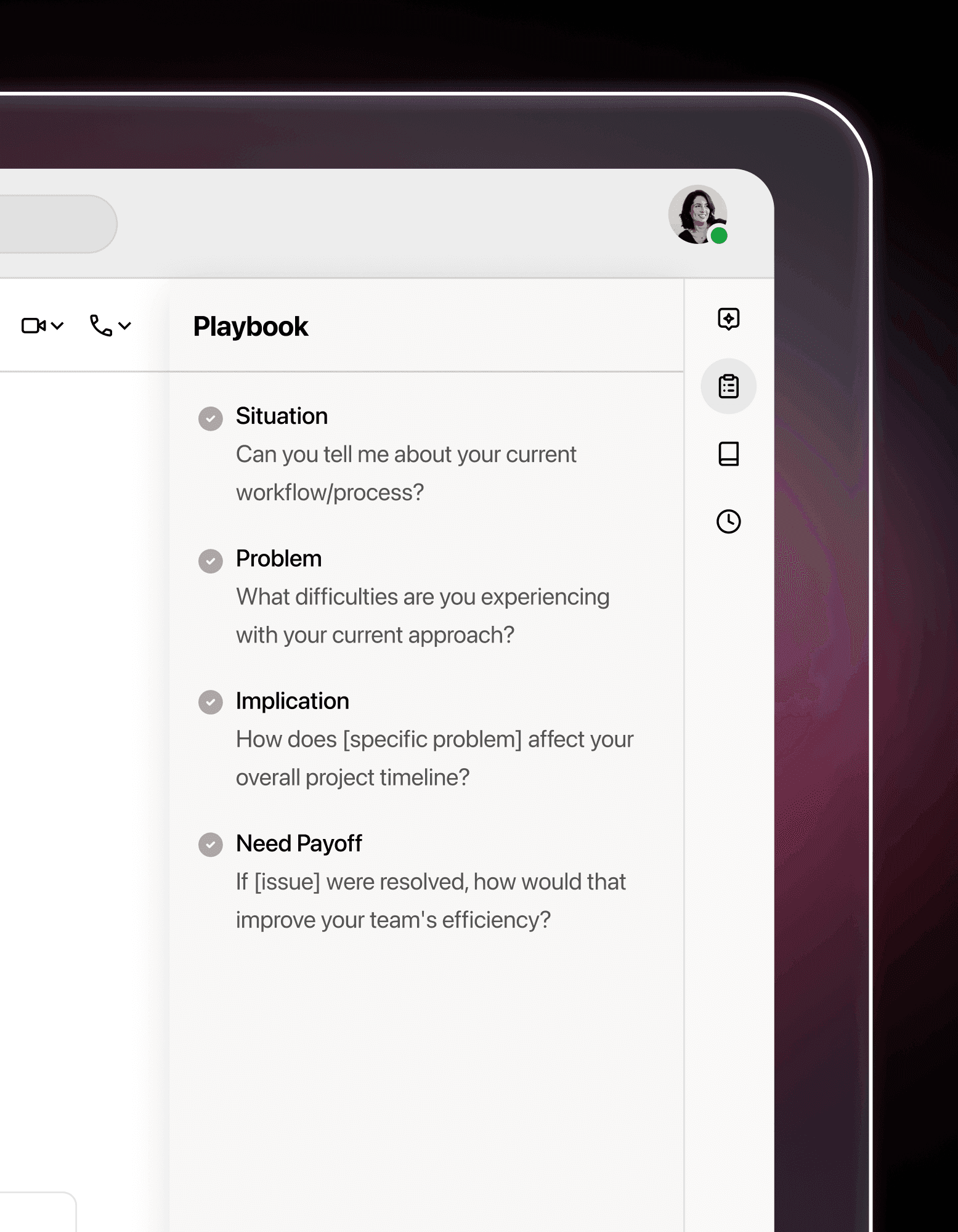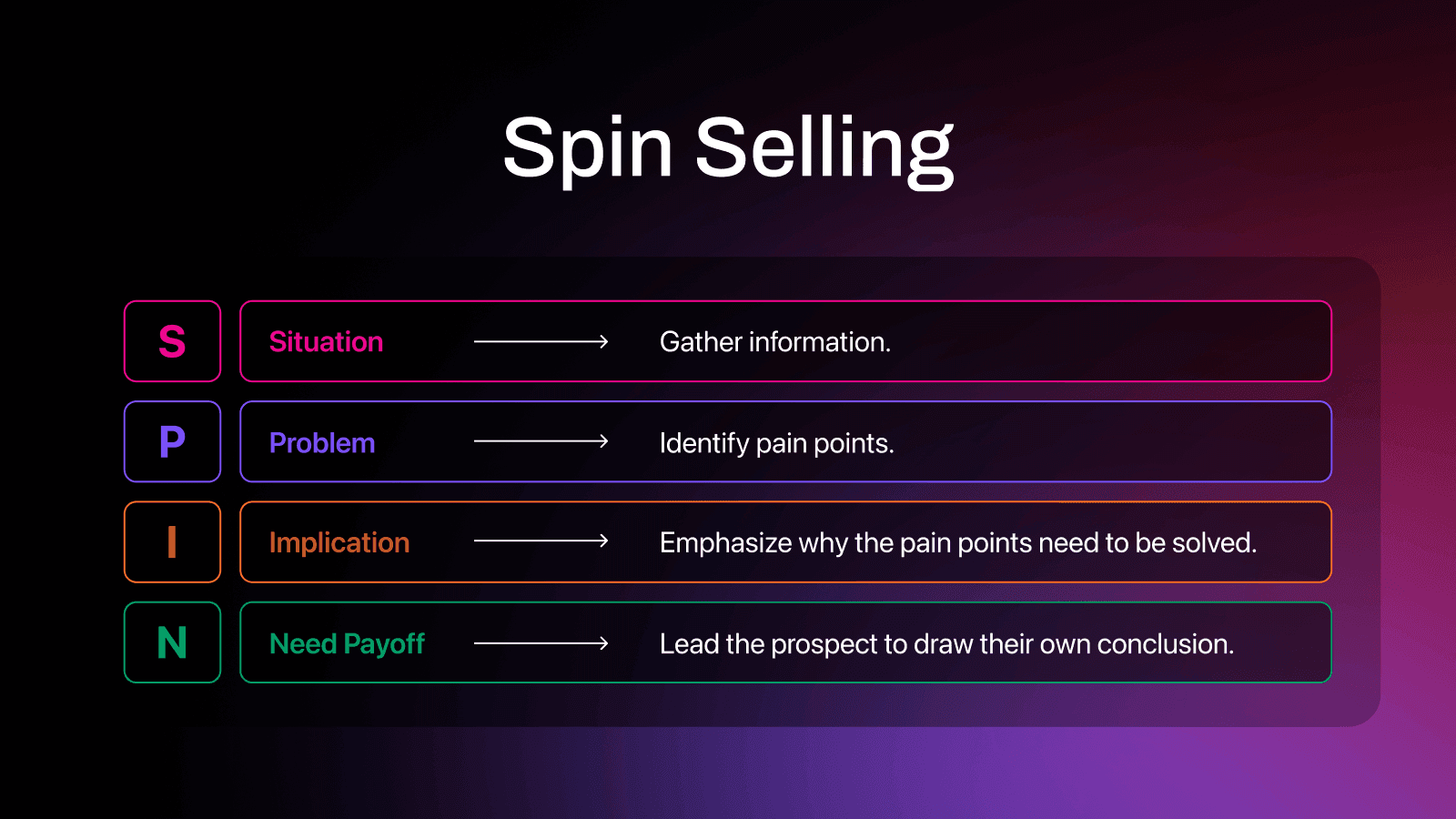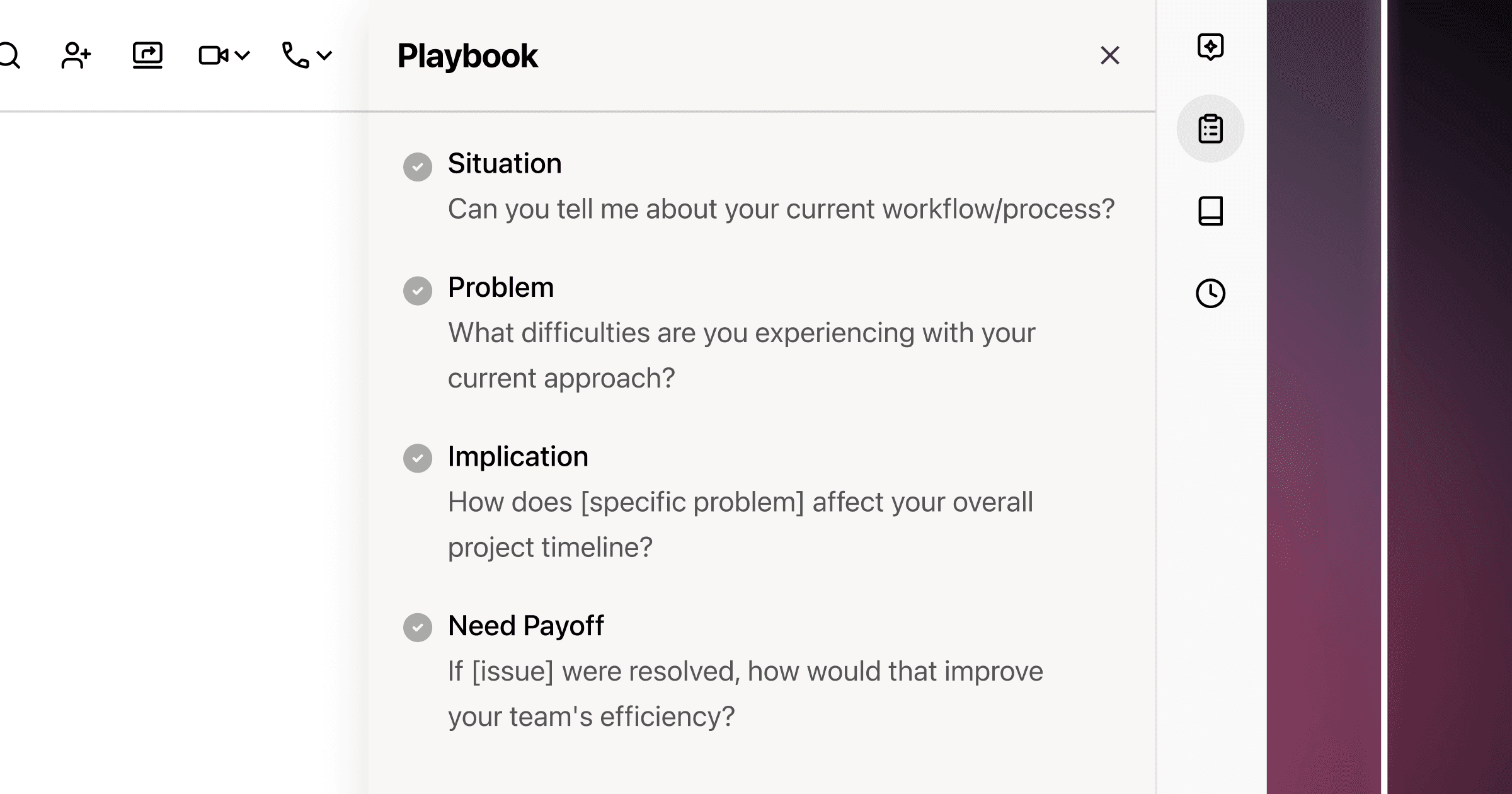What is SPIN selling?
If you’re looking for an AI-powered platform that will help your salespeople with SPIN selling, then look no further than Dialpad Sell Centre.
Book a demo today to see how it works.

What is SPIN selling?
SPIN selling is an incredibly popular (and proven) B2B sales methodology. This framework helps reps to navigate complex sales cycles, providing a structured approach to questioning and problem-solving.
Originally developed by Neil Rackham in the 1980s, the SPIN methodology is based on an analysis of thousands of sales calls. Rackham and his team endeavoured to find what factors led to a successful interaction and built the SPIN methodology around their findings.
The SPIN acronym stands for:
Situation
Problem
Implication
Need-payoff
SPIN provides a formula to help sales reps identify their prospects’ needs and position themselves as trusted advisors to help meet them.
Each aspect of the SPIN acronym refers to a question type that should help move the prospect toward a sale. Let’s take a look at each of these letters and their related questions in a bit more detail.
SPIN questions you could use
The SPIN method in sales is built around four types of questions, each designed to help uncover the pain points of a prospective customer and demonstrate how the product or service you’re selling can solve them.

Situation questions
Situation questions are used to gather background information. They help the seller build a clear picture of the prospect’s current situation and the ins and outs of their existing setup, processes, and challenges.
Gathering this information helps the seller build a rapport with the prospective buyer and provide a more personalised selling experience, maximising their chances of success.
Examples of situation questions may include:
What are the main goals and targets for your organisation?
What tools and software solutions are you currently using?
Can you tell me a little bit about your current workflows and processes?
Problem questions
SPIN selling questions in the problem category allow you to dive deeper into the specific pain points and challenges affecting a prospective customer. Ideally, you hope that whatever you’re selling is well-positioned to address these.
The goal is to make the prospect feel like the product or service you’re offering could’ve been custom-made with them in mind. Problem questions might include:
Are you having any recurring problems with your current workflows and processes?
How often would you say you encounter [specific issue/problem]?
What’s holding you back from meeting your targets this quarter?
Implication questions
Implication questions emphasise to your prospect why their problems need to be solved. They help them realise the impact their pain points are having and that they should look for a solution as soon as possible.
SPIN question examples here might include:
Has [specific problem] affected the timeline of your projects at all?
Has your organisation experienced negative consequences as a result of [problem]?
What would be likely to happen if [problem] continues?
Need-payoff questions
Need-payoff questions lead the prospect toward realising the benefits of tackling their pain points and using your solution to do so.
The aim is to guide your prospect toward drawing their own conclusions, making your conversations feel less like a sales pitch.
Some need-payoff questions you could use include:
Would solving [specific problem] help to boost your team’s efficiency/productivity?
How might solving [specific problem] impact your KPIs?
Do you think any of the products/services we offer might help you overcome [specific problem]?
The aim is to build up a meaningful conversation using these questions. This way, you can help customers realise the value of what you’re selling on their own terms without bombarding them with overly sales-y tactics.
The four stages in the SPIN sales methodology
As well as providing useful questions to ask at each stage, the SPIN methodology outlines specific activities to engage in. This further helps to guide sellers through sales cycles and toward transactional success.
Rather than a hard sales pitch, reps should work toward building a rapport and a level of trust with their prospect. If they need to take a step back to a previous stage to do this, so be it. As long as the end result is a mutually beneficial solution, it’ll be worth it.
Let’s take a look at the four stages of the SPIN sales cycle and how they align with the different parts of the acronym we’ve already identified.
Opening or preliminaries
The opening stage of the SPIN sales process should involve your reps building a rapport with their prospects and setting the tone for the conversation that’s to come.
All sales interactions should be positive and engaging, but this counts doubly for the preliminary interaction. Reps should strive to:
Introduce themselves
Build a connection with the prospect
Lay out the agenda for the sales conversation.
Situation questions help sales reps build a personal connection with their prospects, which is more effective than utilising a generic sales pitch. Reps should understand that they’re not simply selling a product but laying the foundations for a long-lasting relationship.
Investigating
The investigating stage aligns with both the “Situation” and “Problem” parts of the SPIN acronym. It’s when your reps will really dig into gathering information and understanding their prospect’s unique situation and challenges.
Many consider the investigating stage to be the most important part of the SPIN cycle, as it uncovers the pain points and needs of the prospect. The rep can then build their approach around these.
Asking the right questions here is essential to identifying whether your product or service and the prospect's needs align.
Demonstrating capability
Now you’ve identified a problem your product or service can solve, it’s time to highlight this to the prospect. This stage is where you demonstrate the capability of what you’re selling. It lines up with the “Implication” and “Need-payoff” stages.
Your reps should guide their prospects toward the realisation that their pain points must be addressed and that not doing so could negatively affect their organisation.
Once they’re on board with this notion, your reps can highlight how your product or service could help them avoid those consequences.
Obtaining commitment
At last, we arrive at the final stage: Obtaining commitment. This is where your reps capitalise on all their hard work by closing the sale, with their prospect committing to moving forward with your solution.
Now your reps have illustrated the benefits of your solution and their prospect has realised the value it holds for them, they can agree on the next steps of the sale. This may be a purchase, a free trial, or a follow-up meeting.
What happens after a SPIN call? Potential outcomes
A SPIN sales call can result in a variety of outcomes. Best case scenario, your agent will secure a sale. This might not always be the case, but that doesn't necessarily mean it’s been a waste of time.
Here are a few potential outcomes of a SPIN call and how your agents should proceed in each scenario.
A positive commitment to your solution
Sometimes, the prospect agrees there and then that they’ll proceed with your solution. This might mean making a one-time purchase of your product or service, signing a contract, or moving on to the next stage in the sales process.
Your agent should respond enthusiastically to this decision and reinforce that the prospect has made an excellent choice. It doesn’t hurt to show a bit of appreciation, too.
What’s most important is that clear instructions are communicated about the next step. This might mean sending over a contract to be signed, establishing an implementation timetable, or arranging for a payment to be made.
It’s essential that a smooth transition is facilitated between the sales process and the next step in the customer journey. Until a contract is signed, the customer could still change their mind, so don't give them any reason to do so.
Partial commitment to a demo or trial period
Alternatively, the prospect may not be completely sold on your product or service yet but is willing to try it with a demo or trial period. This is a positive thing. Wow your prospect with a taste of what you can offer, and convince them to make a full purchase.
If your prospect agrees to a demo or trial period, the next step is to outline the terms of them trying out your solution clearly. This includes details such as how long the trial lasts, what features will be available, and where they can turn for support during it.
Make sure you schedule a follow-up conversation after the trial has ended. This gives you a chance to gather feedback and/or close the deal with this particular prospect.
Request more information or agree to another call
Some prospects need a bit more persuasion than others, especially those working with a tight budget. Now’s your chance to show them that your solution can give them plenty of bang for their buck.
The prospect may request in-depth pricing details or technical specifications to ensure they’re investing in the right solution. They might even wish to see case studies showing how other organisations have successfully implemented your solution.
If this is the case, make sure you provide these details as promptly as possible. Customise the materials you send where appropriate, highlighting case studies or other information targeting the prospect's pain points or concerns.
Again, make sure you have a follow-up conversation planned in the calendar. This gives you a chance to review any information in more detail and help your prospect make an informed decision.
No commitment but positive relationship-building
Your prospect may not be ready to make a commitment at this time, but you’ve still been able to build a positive relationship with them. With any luck, you’ll get another crack at them in the future when circumstances are more in your favour.
Even if it’s a “no,” express gratitude for their time and wish them well. A positive interaction will help keep you in mind when they start to shop around again. Make it clear that you’d like to stay in touch, and ensure they’ve got your contact details in case they ever need them.
Rejection or realisation that your solution is not a good fit
Sometimes, it’s just not meant to be. It’s entirely possible that after learning more about your solution, the prospect decides it’s not for them and decides not to move forward with the sales process.
It’s important you respect this decision and still offer them your thanks for their time and consideration.
Try to get some feedback about what led them to this conclusion. This way, you’ll have something to analyse and potentially implement to boost your chances of success in future interactions.
How to make the most of the SPIN selling framework
Here are a few top tips for how to make the most of the SPIN selling framework in your sales department.
Dedicate time and resources to SPIN sales training
Providing your agents with dedicated training is the best way to get them up to scratch with the SPIN technique in sales.
Interactive learning and sales coaching are often the most effective approach, as giving your agents practice at handling real sales conversations is a good way to prepare them for using the SPIN framework in the field.
Good SPIN training should focus on the following areas:
Giving sales agents the knowledge to ask the right questions at the right times
How to organically uncover pain points
How to personalise a sales conversation for the best chance of success
Being able to identify when a prospect is no longer responding to a particular tactic and how to pivot accordingly.
Automate SPIN with Dialpad AI Playbooks
A playbook is a useful sales tool that can guide your reps through calls in real time. It’s also handy for managers, providing quick, easy, but valuable insights that can be used to provide training and support.

With Dialpad Sell Playbooks, you can choose from various playbook templates, including ones based on the SPIN methodology. You can even create custom offerings that reflect the specific needs of your business, incorporating elements of SPIN wherever necessary.
These playbooks can then provide support to your sales reps during calls. Dialpad AI monitors each interaction, checking off prescribed behaviours as they’re detected. This helps agents stick to the SPIN methodology throughout the call and allows managers to monitor playbook adherence afterward.
Dialpad AI also guides reps through the Playbook during live calls with handy prompts, ensuring they ask the right questions and collect the right info.
Make your SPIN approach a modern one
SPIN selling first emerged over 30 years ago, but it still has applications to this day. However, it’s important to acknowledge that the typical buying journey has evolved, and tweaks must be made to the SPIN model to keep it relevant.
Modern SPIN selling should focus less on situation and problem questions—after all, most prospects already know their major pain points and don’t want to waste time identifying them for you. The key is to find pain points or opportunities they don’t know about yet.
To this end, more thought-provoking questions can often serve your agents well. For example:
Have you heard that [surprising statistic relevant to their industry]?
Is your organisation aware of [new approach or strategy the prospect could use]?
Have you considered how your organisation will prepare for [upcoming event or change in the relevant industry]?
Another big change since the initial emergence of SPIN selling is social media—in particular, LinkedIn. This can be a valuable resource in sales call planning, giving you insight into your prospects’ priorities and perspectives.
Scouring the LinkedIn profiles of your prospects before SPIN sales calls provides a wealth of information about their personalities, concerns, priorities, and more.
This gives your sales reps a headstart in building a rapport, allowing them to quickly move through the initial stages of the call and get to the juicy stuff much faster.
Finally, the number of stakeholders involved in a B2B deal has grown significantly since the ‘80s. Whoever your point of contact in an organisation is, chances are they’ll need to get approval from at least one other person before they can close the deal.
Come prepared for this eventuality, and arm yourself with the names and job roles of the parties who’ll be involved in the deal. Convey every piece of pertinent information so that when your contact is asked a question, they can answer it immediately.
The more compelling the presentation, the quicker a deal can be struck, so give them everything they need to wow their colleagues.
SPIN to win: Tailor solutions to your prospects
The SPIN selling method helps your agents craft solutions that are perfectly tailored to the needs and desires of your prospects. This positions them as problem solvers rather than pushy salesmen—and we all know who we’d rather do business with.
You can utilise a range of tools and resources, such as social media and AI in sales, to bring the SPIN methodology into the 21st century, arming your agents with everything they need to achieve sales success.
Start using a modern SPIN sales strategy
Overahaul your sales approach with Dialpad Sell Centre. Book a demo, or watch a tour of the Dialpad app!
